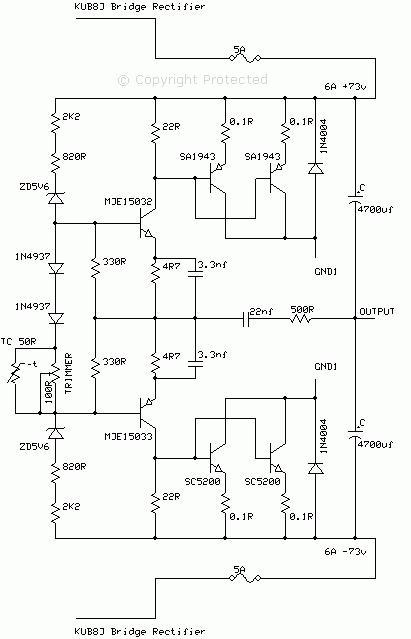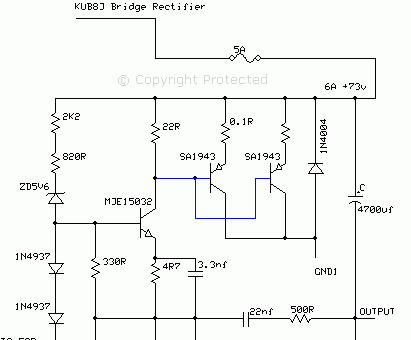PBM8 500 MKII Diagnostic Logic
In a Class AB complementary symmetrical output stage, there are usually power resistors that connect between the emitter terminal of the transistor, and the power rail. The PBM8-500 has six such resistors per channel. The 0.1 Ω resistors are in the direct path of high current, and they usually experience a surge of current when the amplifier powers. These resistors are also more likely to dissipate heat and fail over time. When the 22 Ω resistors fails, the power transistors in the next stage receive a higher current at their base junctions switching them on fully. Usually, when power transistors conduct fully, damage occurs readily and they fail.
Open 0.1 Ω Resistor

In this design, each power transistor in the final output stage has a 0.1 Ω resistor connecting from the emitter to the power rail. Since the resistors are in parallel, the inrush of current -- when the amplifier powers -- is split between them, however, if one of the resistors was open, then all the current would have to pass through the other transistor.
In this case, I found one of the 0.1 Ω resistors had failed in each pair. This means that one transistor was carrying the entire load. At low volumes, the amplifier worked fine as the load did not exceed the transistors current rating. However when the volume was turned up fully the current flowing through it exceeded its rating which caused it to short.
Logic

In this diagram, the signal in blue feeds the base junction of both power transistors. When one of the 0.1 Ω resistors fail, the transistor it connects to does not conduct. Hence, in this circuit only one transistor conducts and takes the entire load shown by the red path. This type of fault can occur on both complementary pairs.
Haylie Westernra
Usually a failed resistor is not apparent because the channel appears to work fine due to one transistor still conducting. However, turning the volume up drives the transistor harder causing it to short and blow a fuse. The short can appear intermittent because it depends upon the input level fed to the amp at the time. This amplifier always blew the fuse when Haylie Westernra hit the high note.
Check Both Channels
If you come across this type of fault, it is probably a good idea to check both channels even if the channel appears to be working, and in particular look for open 0.1 Ω power resistors. In a circuit like this, where only one transistor shorts, it is a big clue and a giveaway as to what could have gone wrong. Of course, I knew this straight away, which is why they call me the "Love Joy" of the electronics world. Electronics is an exact science, which follows a precise predictable rule.
This Article Continues...
PBM8 500 MKIIPBM8 500 MKII Inside Look
PBM8 500 MKII Diagnostic Logic
PBM8 500 MKII Fault Solved!
Power Resistor
Amplifier Heat Sink
Class AB Amplifier
How to Check Transistors
GCA5200T and GCA1943T Transistors
2SC5200 2SA1943 Transistor Replacement
PBM8 500 MKII Diagnostic LEDs
PBM8 500 MKII Power Supply